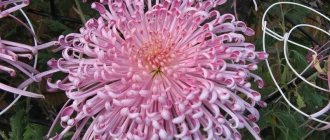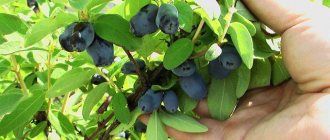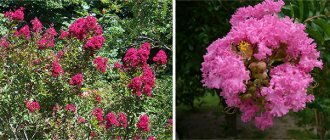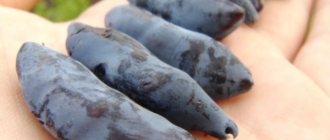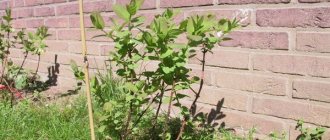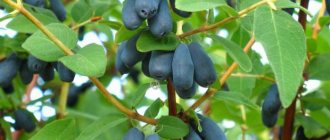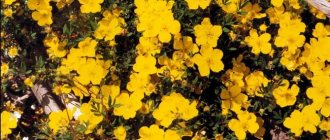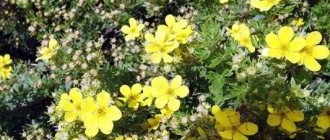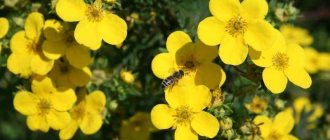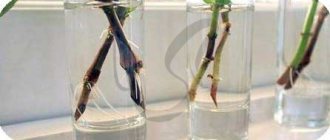Indian Duchesnea or also called Indian cinquefoil (Potentilla indica) is a species of herbaceous perennial plants of the Rosaceae family. In addition to these names, it is also called fragaria, Indian strawberry, Indian perstache and pseudostrawberry. This miracle plant appeared in the 19th century, thanks to the French botanist Antoine Duchesne. It was his name that formed the popular name.
What is the difference between Duchesnea and strawberry:
It has a great external resemblance to the common strawberry. It has small basal rosettes formed with the help of triangular leaf plates, shoots similar to mustaches and reaching 50 cm in length. They differ in their flowers and fruits. The structure of the flowers is the same, but the colors are different. Dushea is famous for its yellow flowers. The fruits are round, bright red and covered with distinct small seeds. They look upward, and ordinary strawberries grow drooping berries. Each duchea fruit contains a large amount of vitamins and many other useful elements, which is the same as strawberries, but its taste is much lower. Their taste is bland, but due to their high wateriness, they can quench your thirst. Under natural conditions, this beautiful plant grows in the South and East of Asia.
Description of Duchesne
Duchesnea was first discovered in southeast Asia. Gradually, decorative strawberries spread to other continents. The natural habitat of the culture is limited to the countries of Eurasia, South and North America.
In the scientific literature on plant growing, the perennial is characterized as a flexible herbaceous bush with a short rhizome and creeping shoots. The length of the thin stems is up to 1.5 m. As it matures, mustaches appear, surrounded by a rosette of leaves. In contact with the ground, the rosette soon takes root. They go deep underground and serve as reliable support.
The surface of the pale green leaves is rough, the tips are trifoliate, cut with small teeth. The foliage shape is oval. On the reverse side there are tubercles of veins that connect into a basal rosette.
Blooms with miniature single flowers. The diameter of the bud when opened is no more than 1.5 cm. The color is yellow or cream. The corolla is formed from 5 petals. Each flower consists of 30 stamens. The flowering phase takes almost the whole summer.
The crop bears fruit with round red berries, covered with seeds on top. The berries have no taste or smell.
Most novice gardeners do not distinguish between duchesne and ordinary strawberries. Both plants have similar external characteristics. However, the berries of the strawberry are lowered down, and the fruits of the duchenee stick out to the top.
Can Duchenee be eaten?
The fruits of this plant are quite edible, but you should not eat a lot of them at once. In large quantities, fresh berries can lead to poor health. For allergy sufferers, pregnant and lactating women, children and elderly people, the fruits of this plant are contraindicated. When using medicinal products based on it prepared by traditional healers, it is necessary to consult a doctor.
Duchesnea has been grown as a cultivated plant since the 19th century. It did not leave gardeners from all over the world and, of course, our country indifferent. It is grown everywhere, both in the Siberian regions and in the south of the country. If you plant it in a flowerpot, it can decorate the terrace, balcony and windowsill.
Useful properties and features of Indian strawberries
The following were found in Duchenne fruits:
- Sahara;
- organic acids;
- pectin, nitrogenous and tannins;
- organic alkali;
- salts of iron, calcium, phosphorus, manganese;
- vitamins of groups B, C, carotene and folic acid.
The antitumor properties of Indian cinquefoil have been proven. Berries have a tonic effect on the entire body, have a positive effect on the gastrointestinal tract, and restore salt deficiency. In cosmetology in some countries they are used as part of face masks. Indian Duchesnea is a natural antiseptic; in the East it is used to heal small ulcers, puncture wounds and even snake bites.
Attention! The plant is not poisonous, but eating the berries in large quantities is not recommended. Duchesnea fruits are contraindicated for nursing, pregnant women, and children.
It is successfully used in landscape design as a ground cover crop. It grows with lightning speed and can “clog” low-growing crops. Therefore, when planting duchenea in flower beds and alpine hills, it is necessary to control the creeping cinquefoil. Feels great in flowerpots as a herbaceous hanging plant. Hanging down stems with red berries look impressive. Many people have duchesnea growing on the windowsill in their room. Fruiting of the crop in such conditions will continue in winter.
Frost resistance:
Duchesne is suitable for moderate warm climates; it does not require special care and winters well under a layer of snow. When frozen, it quickly recovers when the weather warms up, but only if at least a couple of sockets remain. It requires annual renewal, but you won’t have to look for a new place for it, as is the case with ordinary strawberries. The plant can grow in the same area for many years.
There is an opinion that it is Duchesnea that is depicted by world-famous masters in paintings made in the Khokhloma style. As confirmation, they talk about the yellow petals that are visible there. At that time, these berries were already actively cultivated in our country, but it was still known as fragaria.
Indian Duchesnea: video
Syn: Indian strawberry, false strawberry, Indian cinquefoil, pseudostrawberry, fragaria, dusheniya.
A perennial herbaceous plant with trifoliate decorative leaves, small yellow flowers and bright red fruits. Indian Duchesnea is an ornamental garden plant and a popular potted plant. Due to its many beneficial properties, Duchesnea is used in medicine in many countries.
Table of contents
In medicine
Duchesnea indica is not officially used in medicine in the Russian Federation, but in Asian countries it is famous for its medicinal properties and is successfully used in folk medicine and homeopathy. Possessing anti-inflammatory, antitumor, antiseptic properties, Duchenne fruits are used for improper functioning of the digestive system, for the treatment of the liver and pancreas. In China, stomatitis is treated with the juice of Duchesne berries. A decoction of the leaves of the plant is used to treat puncture and other types of wounds and burns. The antitumor properties of the plant have been scientifically proven; residents of many Eastern countries use the fruits of Duchesne for the prevention of cancer and in complex anticancer therapy.
Contraindications and side effects
Eating duchesne berries does not cause any side effects, nor does it cause any particular pleasure from eating them. Is duchenea edible? The fruits of the Duchesnea plant look like strawberries; they are healthy, but tasteless. In large quantities, the berries are toxic and can cause mild poisoning. Contraindications for use are individual intolerance, a tendency to allergies, as well as pregnancy and lactation, and childhood.
Seed growing method:
Seed germination persists for 2 or even 3 years, for this reason propagating the plant by seeds is not at all difficult and quite effective. Before sowing, seeds must be stratified. To do this, in the last days of January, you need to wrap them in moistened gauze, wrap them in plastic and put them in the refrigerator where the vegetables are stored. They should remain there until spring. During this entire time, the gauze must always be damp.
As soon as the seeds pass stratification, they can be sown. To do this, you need to use wide-sized containers filled with an earthen mixture of sand and peat. Plastic containers with a lid will also work.
When sowing, the seeds do not need to be buried; you can only sprinkle them a little. Next, the soil is sprayed with a spray bottle and covered with film or glass in order to retain the moisture the plant needs.
Picking Duchesnea is very difficult due to the fragility of small gatherings; at this moment the seedlings may die. In order to avoid this, it would be more correct to use seedling cassettes, where there is light and nutritious soil, and plant a seed or two there. You can use a toothpick to sow small seeds.
Every day the soil with seeds must be ventilated by lifting the film. The lighting should be diffused, and the thermometer should show from +22 to +25 degrees.
Spray using a spray bottle when the soil dries out. Liquid stagnation should not be allowed; this leads to the development of rot and, as a result, to the death of the entire crop.
After the first leaves appear, it is necessary to remove the shelter.
As soon as 2 true leaves appear, it is necessary to pick them in different containers for their further development.
Fertilizing is carried out with nitrogen-based fertilizers at intervals of 14 days. The concentration of fertilizers should be half that indicated on the label.
Planting in an indoor garden plot occurs after the threat of frost has passed, usually in May. The place should be protected from the winds, and also be located where the plants will not be exposed to sunlight during the day. By the time of planting, they should have a well-developed rosette and the plant should reach 8 cm. When transplanting from a container or pots, it is important to keep a ball of earth on the seedlings. It serves as protection for fragile roots.
There is no need to plant flaccid, small plants in the garden; you can grow them at home, otherwise replanting will lead to death. As soon as August arrives and the sun is no longer so strong, they can be planted in the garden. Before the onset of winter cold, they will have enough time to adapt to new conditions and take root. It is possible to postpone the transplant to the next spring season. But in this case, the seedlings should be kept in a room during the winter months where the thermometer will show from +10 to +15 degrees.
Growing Indian cinquefoil from seeds
Indian Duchesnea seeds photo
The seeds remain viable for 2-3 years, so there will be no difficulties with seed propagation. It is important to carry out stratification: at the end of January, wrap the seed in damp cotton wool or gauze, wrap it in cellophane and place it in the vegetable section of the refrigerator, where the bundles will remain until March. During the specified period of time, make sure that the gauze or cotton wool is damp.
- After stratification, sow in wide containers with a sand-peat mixture; you can sow in a plastic container with a lid.
- The seeds are very small and should not be deeply buried; literally scatter them over the surface of the soil.
- Moisten with a spray bottle.
- Cover the top with film or a piece of glass, a transparent lid to create conditions of high humidity.
Small and fragile duchesnea seedlings will be very difficult to pick, and there is a high risk of seedling death. To prevent this, it is much wiser to plant 1-2 seeds in the cells of seedling cassettes with loose nutrient soil. Small seeds can be planted using a toothpick.
- The shelter will need to be raised daily for ventilation.
- Maintain diffused lighting and temperature in the range of 22-25 °C.
- As it dries, spray the soil with a spray bottle. Remember that stagnation of moisture is fraught with the development of rot, which can completely destroy the crops.
- When the seeds hatch, you can remove the cover.
Indian Duchesnea from seeds photo shoots
- Continue moderate watering, and at the stage when a pair of true leaves appear, plant them in separate pots for continuous growth, if sown in a common container.
- Every 2 weeks, fertilize the leaves with nitrogen-containing fertilizers at a concentration of 50% of the dose recommended by the manufacturer.
You can plant seedlings on a site (in open ground) in May with the establishment of real heat in an area protected from the wind and the burning midday sun; the plants must have a developed rosette of leaves and a height of at least 7-8 cm. To obtain ready-made seedlings, transfer the plants to peat or plastic cups for growing, after which it will be convenient to transfer them while preserving the earthen clod.
Do not plant weak, small plants; it is better to leave them indoors: fragile plants will not tolerate being transplanted into the ground and will die. It’s better to wait until August, when there is no summer heat and there is enough time for rooting to prepare the plants for winter. In some cases, it is allowed to plant seedlings in the next season in the spring, providing the plants with cold conditions in winter at a temperature of 10-15°C.
Choosing a place in the garden:
For Duchesnea, partial shade and a place where water does not accumulate are most suitable. Trees and large shrubs can become excellent neighbors for it. If you water regularly, the plant will be able to develop well in areas exposed to the sun. Lowlands and areas with high groundwater levels are not suitable for the plant. In the second case, if there is no other place, you can make an artificial earthen hill. This condition must be met, since the plant is not tolerant of stagnant water and its root system in such areas will rot.
Duchenne is not suitable for fertile soils; it will grow best in loose and moderately nutritious soil, as well as with good water and air permeability. If Duchesnea is grown in a vase, you can make a soil mixture with your own hands. Deciduous humus, turf soil and sand are ideal. They must be mixed in proportions 2/1/1. You can also buy suitable soil at a nursery.
When preparing the site, it should be taken into account that per 1 sq. There should not be more than 9 seedlings per meter.
Support and support
Indian Duchesnea is an unpretentious perennial that requires minimal care. In order for the plant to always look good, it is necessary to regularly remove drying leaves from it - cut them along with the petioles as close to the base of the stem as possible. However, in no case should you remove fading flowers from the plant, since it is from them that decorative berries are formed. In autumn, when the fruits begin to turn brown and lose their attractiveness, they can be removed along with the peduncles on the ends of which they sit.
Indian duchesneas growing, especially in flower pots, need regular watering - the soil should always remain evenly moist. From autumn to spring, the growth rate of the plant slows down, so watering is limited. You can also spray the plant with water at room temperature in spring and summer.
In the spring, duchenea is fed with long-acting fertilizers. They are also added to the ground during planting. Or complex mineral fertilizers are applied once a week.
It is important to provide the duchesne with good lighting, but it is desirable that at noon, at the very peak of solar activity, the plant is slightly shaded.
Severe frost can seriously damage the leaves of a plant, so care should be taken to ensure reliable protection for plants growing both in open spaces and on terraces or balconies. In regions like ours, with cold winters, it is best to take Duchesne into a house or greenhouse. And duchenea growing on a hill or open space must be covered.
The fruits of the plant are often attacked by slugs and snails. Plants growing in hanging baskets do not need protection from these pests because they simply cannot reach them. Duchesneis growing in flower pots need protection. To do this, the edges of the container are lubricated with Vaseline. You can also place flower pots on a special mat to repel pests. Another protection option, especially when growing in open soil, is to sprinkle the ground with pebbles or special “Thunderstorm” granules against garden snails and slugs.
Light specks on the leaves of the plant are a sign of its damage by spider mites, which often attack Duchesneis growing in a greenhouse or conservatory. To destroy pests, use the most suitable insecticide.
We thank biologist Elena Ignatieva for her help in preparing the material
Duchesnea is used:
| As a ground cover plant | In the hedges |
| Between conifers | As an ampelous plant |
Care requirements when growing indoors:
Suitable pot
Duchesnea grown at home looks great everywhere, regardless of the interior, and can please the eye for many years. It is perfect for a flowerpot, a large pot and will look great in a hanging pot because of its branchy shoots. A rounded support that can be installed can be used to create a spectacular flower arrangement if you direct the stems towards it.
Temperature conditions
The plant will be very comfortable on a terrace or open balcony in the summer, and in winter it will be better indoors. Duchesnea is not afraid of temperatures dropping to +5 degrees, but temperatures from +12 to +15 are better suited for her in the winter months. During this period, the plant enters vegetative rest, so diffused light and minimal watering will be quite sufficient.
When to replant, water and feed:
During the spring-summer period, plants grown in pots must be watered as soon as the top layer of soil dries out. Every year, in the spring, it must be replanted, transferring it from one pot to another. The size of the pot should be slightly larger than the size of the root system. During the same period, it is necessary to feed the bush with complex mineral fertilizers.
How and when to prune:
Fruit formation occurs in withered inflorescences, so they are never removed. Flowering stems are removed along with the fruits after the latter lose their attractive appearance and become dark in color. In order for Duchesneya to retain its decorative properties, it is necessary to remove those leaves that have dried out, but not at the base.
A little about this amazing plant
Our beauty comes from Southeast Asia, has lived in Europe since 1804 and has great success due to its incredible unpretentiousness and attractive appearance.
It is simply irreplaceable in landscape design and park art.
The fact is that it can be grown as
a ground cover and hanging crop .
The ability to wrap around a support makes it possible to arrange not only hedges, but also intricate structures of various types.
The fact that this plant is a perennial .
It is not necessary to constantly plant it - it is enough to rejuvenate it by pruning.
Duchesnea has taken root not only in parks and squares; it often decorates home interiors, verandas, loggias and balconies.
Such a universal plant is Duchesnea Tutti Frutti indica.
Caring for a plant in the garden:
Caring for the plant is not difficult and does not require much time. You just need to follow a few rules:
Duchenia needs to be watered regularly and abundantly, especially during hot and dry periods, not allowing the leaves to dry out so that appetizing fruits form on them. In the garden, it is best to water the plant by sprinkling in the early morning or late evening. If strawberries grow in an open sunny area, then during periods of extreme heat, you can use a net to create shade. This will help protect it from burns.
In order for oxygen and nutrients to penetrate better and faster to the roots, it is necessary to regularly weed and loosen the soil. To prevent weeds from growing longer, you can cover the ground around the plants with sawdust mulch, which will also help retain moisture in the ground for a longer time.
Applying complex fertilizers in the spring will help the plant develop better. It is important to follow the instructions in the instructions when using.
How to care for Indian duchesne in open ground
Indian Duchesnea planting and care in open ground Photos of berries
Caring for the plant is not labor-intensive and includes simple agrotechnical techniques:
- Regular watering, especially in extreme heat, so that the leaves do not dry out and large, beautiful berries appear. Treat Duchesnea garden plantings in the summer heat with sprinkling (in the morning or evening before sunset). If the heat is at its peak and the planting location is sunny, you can shade it with a net so as not to burn the beautiful “precious” berries;
- Young plantings should be cleared of weeds and the soil should be loosened periodically. If you mulch with sawdust or coarse sand, these procedures can be avoided, and mulch also helps maintain soil moisture longer.
- Spring fertilizing with complex fertilizers (for example, nitroammophos) according to the manufacturer's instructions has a positive effect.
How to prepare for winter cold:
If pots are used to grow Duchesne, then for the winter it should be placed in a place where the thermometer does not rise above 15 degrees and does not fall below 10.
The one in the garden will feel great under a layer of snow. In case of a small amount of snow, it is necessary to mulch the plants using spruce branches and dry leaves.
Types and varieties of Duchesnea
There are only 2 types of perennial. Indian Duchesnea (Duchesnea indica) is used for growing in the garden. In some countries it is called Indian strawberry or bloodroot.
Creeping shoots are from 30 to 100 cm long. Internodes are capable of rooting. The foliage is a rich green tone, the surface is pubescent. A lush rosette is formed from the leaves. The buds are located singly on elongated peduncles. The diameter of the yellow-colored flowers is from 1 to 1.5 cm. The berries against the background of greenery are striking. The size of the fruit does not exceed 2 cm. Apart from their attractive appearance, the berries do not have any nutritional benefits.
Varieties of Indian Duchesnea include:
- "Variegata" with variegated leaves. The plates are decorated with white spots of a reddish color;
- "Snowflake" stands out for its small bright leaves edged with a snow-white edge. The color of the buds is also white.
Possible diseases and harmful insects:
Duchenea can get powdery mildew, fusarium, phyllosticosis, and anthracnose. All of them are very dangerous for the plant. The invasion of spider mites, aphids, Colorado potato beetles, slugs and beetles is also dangerous. To combat diseases, fungicides must be used. They can also be used during prophylaxis.
To control pests, insecticidal preparations must be used. They should be used for prevention, without waiting for an encounter with harmful insects. To scare away Duchesnei-loving slugs, crushed egg shells or pebbles scattered near plants will help.
Appearance
Duchesnea is called Indian or false strawberry for its similarity to this crop.
The leaf is very similar to strawberry in shape and color.
Like strawberries, it produces creeping shoots with rosettes of young plants up to one and a half meters .
The flowers are similar in structure to strawberry flowers, most often yellow in color, but there are also varieties of Duchesnay with white flowers .
The bright red berries are similar to strawberries and can be eaten, but they do not have a strong taste.
The plant is remontant, blooms and bears fruit throughout the growing season in open ground and constantly at home.
You can visually familiarize yourself with Duchesnea Indian Tutti Frutti in the photo below:
Glycemic index of foods for diabetics: what is it, benefits, tables
How to propagate Duchesnea:
The plant can be propagated by division, using shoots formed on the roots or tendrils.
In the first case, reproduction occurs in the spring or in the last days of summer. And if the plant is grown at home, then only during transplantation in the spring. To do this, you need to remove the plant from the ground, clean the roots and cut them into two or three parts with a sharp, disinfected knife. To process sections, you need to use wood ash or activated carbon. In the garden, everything is done in exactly the same way, with the exception that the plants will need to be dug out with a sharp shovel.
In the second and third cases, the plant can be propagated when a root system is formed on the leaf rosettes located on the shoots and tendrils, of which a large number appear during the growing season. If it is difficult to root shoots on the site due to lack of space, then you can do this in small pots, placing them nearby. Separation from the mother plant occurs after the shoot or bush takes root.
Reproduction process
False strawberries can propagate by seeds, division of the bush or rosettes.
The most universal propagation method for gardeners is considered to be dividing the bush into several parts. The shoots are separated from the mother bush and planted in a separate container. Young plants can be planted directly on a stand or directly on a bed (flower bed) in open ground.
During the period of active vegetative growth, a mustache grows from the rosette, which is located at the root of the Indian cinquefoil. This antennal process, like a strawberry, has its own rosette. Such sockets should be rooted. At the current stage, they are allowed to gain strength and are not cut off from the mother bush. Over time, the young rosette develops its own root system and then it can be planted.
Popular: Graceful, easy-to-care coniferous bushes in garden plots
If the plantings are too dense, then the young rosette can be placed in a plastic cup with soil to root immediately. After strengthening the new rosette, the plants are divided. After some time, the young bush is planted in a permanent place.
Indian bloodroot can also be propagated using seeds. Planting material can be purchased at the store. If you carry out the procedure of stratification of planting material, the germination rate increases. The first shoots appear not after six weeks, as planned, but after two.
Therefore, it is recommended to put planting material in the refrigerator for seven days. After this, the seeds are planted in separate pots and, as they grow, transplanted to a permanent place. Even if you grow this plant from seeds, it begins to bloom in the first season.
To prevent false strawberries from being attacked by slugs and snails, who so love to feast on its juicy fruits, it is recommended to pour pebbles and crushed chicken shells into the rows. If you decide to take the bushes in pots for indoor plants outside, then the containers should be hung in flowerpots, and their edges should be greased with Vaseline.
Use for medicinal purposes:
Translated from Latin, the name of the plant “Duchenea” speaks of power and strength. This is due not only to the fact that it grows well and survives under unfavorable conditions, but also because it has medicinal properties.
The fruits of this plant are not dangerous to health if you do not eat a lot of them at once. They do not have a special taste, but they contain a large amount of fiber, tannins, pectins, iron, calcium, alkaloids, phosphorus, folic acid, vitamins B and C, which in itself speaks of the unconditional benefits of these berries.
American scientists have proven through their research that this berry is able to fight and defeat cancer cells. However, at the moment only traditional healers use them to prepare medicines. Especially often in Asian countries.
Infusions prepared from duchenee fruits relieve inflammation of all types, tone, have a sedative effect, and are used as an antiseptic. Eating berries is recommended for problems with the digestive system, liver, pancreas and cancer. For stomatitis, cuts and snake bites, berry juice is used. To cope with insomnia, depression, and neuroses, a decoction made from the leaves of the plant will help. Using the same decoction you can speed up the healing of various wounds and burns. Berries can be used to prepare masks that can saturate the skin with vitamins. The maximum effect can be achieved when using fresh fruits, but they will retain many beneficial properties if they are dried or frozen.
Edible or not
Indian Duchesnea is similar in appearance to wild strawberries. A distinctive feature of cinquefoil is its yellow flowers that turn into fruits. The fruits of the plant are berries located on short vertical stems. The taste of the berries is not as sweet and aromatic as strawberries, but fragaria is also very healthy. The berries contain useful substances such as:
- Sahara;
- Organic acids;
- Pectin, nitrogenous and tannins;
- Organic alkali;
- Salts of iron, manganese, calcium, phosphorus;
- Vitamins B, C, carotene and folic acid.
Indoor geranium: home care for beginners, types and varieties of pelargonium with names and photos, how to grow and prune, why fragrant geranium does not bloom
Despite the rich composition of Duchesnea fruits, it is not recommended to consume the berries in large quantities. The fruits of the plant are also contraindicated for children, pregnant women and women during lactation.
Growing Indian duchesne will not cause trouble and does not require much work. To prevent the plant from getting sick, the main thing is to avoid over-moistening the soil or exposing it to direct sunlight. Following simple rules will allow you to grow a strong, flowering and fertile plant.
Harvest and storage:
To prepare raw materials, you need to start harvesting when the receptacle turns dark red and the berries can be easily removed. Next they need to be sent for drying. The temperature should be between 45 and 50 degrees. Both a special dryer and an oven are suitable for this. Next, the fruits are placed in glass containers and tightly closed with lids. A dark place and room temperature are suitable for storage. Such healthy fruits can be stored for 2 years.
To dry the leaves, you need to lay them out on paper or fabric in an even layer. The place should be in the shade and well ventilated. In order for them to dry evenly, they need to be moved. For storage, use paper bags or glass containers. Can be stored for 2 years in a warm, dry and dark place.
Procurement of plant raw materials
The most useful parts of Indian cinquefoil are the leaves and berries. They can be prepared for the winter. The fruits are recommended to be eaten fresh, but they can be dried and frozen. With this treatment, the amount of nutrients is reduced.
When the receptacle turns dark red, the berries are easily separated. This is a sign to the gardener that it is time to harvest. You can dry the berries using an oven or dryer at a temperature of 45 to 50 degrees. After drying, the false strawberry fruits are placed in a glass container and stored in a dark place. In this form they can be stored for up to two years. It is enough to remove the collected leaves in the shade and dry them in a place that is well ventilated. In order for the plant material to dry more evenly, the leaves are turned over from time to time, then they are put away in a dark, dry place. The leaves have a shelf life of about 24 months.
Loading…
Seed selection
Seeds should be selected based on where the primroses will be grown. Primrose needs cool air temperatures, so this temperature should be within ten degrees to increase the flowering period of the plant. These factors should be taken into account.
If you grow primrose at home, you can safely choose the seeds of common primrose.
When buying seeds, you should pay attention to their expiration date and storage conditions. Before sowing, plant seeds are most often stored in the refrigerator , which increases the chances of good germination. It is necessary to immediately purchase seedling mixture and fertilizers special for this plant.
